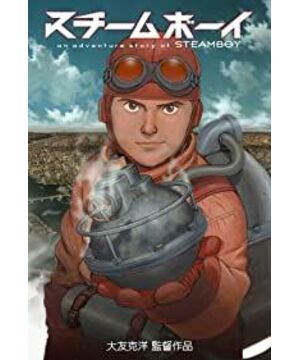As a staunch supporter of science fiction, this film is a strong proof that Otomo Keyang has taken the science fiction route to the end, but the story is no longer the future or the near future. Otomo Keyo turned his attention to the past this time, just like the popular Sakura Wars, telling the unknown fantasies in the gaps of history. The film still continues the style and themes of Otomo Keyang's previous works: passionate youth entrusted with important responsibilities, mechanical industry and the collapsed world, material versus civilization, etc., but compared to previous works, this work is similar to the plot of the city in the sky, It makes Otomo Keyang no longer obscure and difficult to understand, relatively approachable, and more visible.
All ideological doubts and changes in social values and ideology in modern society are related to the rapid development of machinery industry and financial trade. The source of these factors that greatly shocked human development began in the 19th century in England the industrial revolution. It can be said that after entering the 21st century, Otomo Keyang tried to trace back to the source and give a summary of his favorite mechanical stories and reflections on the industrialization era. So the story of the film takes place in London, England during the Industrial Revolution in the 19th century.
In London, when the age of mechanical reproduction was just beginning, the steam engine began to occupy the industrial field. With the advancement of science and the improvement of technology, all kinds of incredible magical inventions have become proofs that challenge the limits of human beings, and at the same time have become cash cows due to commercial applications. On the eve of the first World's Fair, the mania for invention was at its peak. 13-year-old Ray is such a child who loves scientific inventions. His father Eddie and grandfather Lloyd are both famous inventors. Now they are being invited to visit the United States. On this day, Ray received a very strange metal box sent to him by his grandfather from the United States at home. This box contains the magical epoch-making invention of grandfather Lloyd and father Eddie: a "steam ball" that can use energy to generate terrifying power. But Ray was still kept in the dark. He didn't know that with great power comes great responsibility, and disaster followed. The O'Hara consortium, which has long coveted this major invention, claims to be willing to pay sky-high prices to buy the box. Even get it by any means. With the help of his grandfather Lloyd, Ray escaped with the box. And he learned the secret of the steam ball from his father. From that moment, the young Lei was involved in a terrible conspiracy and adventure. At the same time, the young Lei also became a key figure in saving the future of the world!
Character setting is not new, we have seen too many stories of teenage saviours. Whether it's Watano in the hilarious Evangelion Tan or Iodine Shinji in the no-nonsense Evangelion, or Kaneda in Akira, who is best known as Otomo Keyo himself. Look at Lei's familiar face, the firm expression on his face is the same as that of Jintian. I can't help but sigh that the Japanese, who advocate purity, pursue extreme beauty, and have doomsday complexes, always like to hand the world into the hands of some children, instead of finding superman to save them like Americans. Because they think that the short and gorgeous youth is the most powerful. Compared with the simple individual heroism of the Americans, the salvation of these teenagers to the world is also a process of self-reflection and perfection, a kind of growth and cultivation. It is also the embodiment of the idea of rebirth after the destruction of the Japanese. The younger you are, the more hopeful you can build a completely different reality out of this broken adult world.
Although the storyline is relatively simple, will the steam ball eventually become a "blessing of mankind" or a "desire of the devil"? But the story framed by a few basic characters gets rid of the slightly loose and fragmented weakness of Otomo Keyang's cartoons. Whether it's father Eddie and grandfather Lloyd's swing between scientific ideals and the temptation of money, Ray and the reactionary organization's pursuit of the "steam ball", and the hazy relationship between Ray and Princess "Scarlett", everything has been done. It is delicate, vivid and full of tension.
As a cartoon, the picture effect of "Steam Boy" is more eye-catching. Well-designed characters, gorgeous colors beyond imagination, rich three-dimensional picture layers and perfect combination with hand-painting and CG, and rhythmic editing make watching this film a luxurious visual enjoyment. In terms of soundtrack, it continues Otomo Keyang's consistent high level. Mokase Kei's collection of classical and modern music is unforgettable.
Otomo Keyang tries to tell us in the film that machinery is machinery. Humans are the ones who manipulate. The reality that machinery exists as a physical phenomenon does not have any conflicting relationship with the existence of human beings. All results can only be the responsibility of human beings themselves.
This kind of love science fiction, reflecting the attitude of human beings with the most sensitive heart in the cold mechanical steel jungle, can also be said to be an obsession of Otomo Keyang. It is nothing to have a firm belief, but it can be called greatness to be firm to the end.
In Japan, a country that can be described by chrysanthemums and swords, it is not surprising that an animation supervisor with extreme individualism like Otomo Keyang was born. The characteristics of division and unity in nationality, tradition and innovation, extreme and neutrality are embodied in his works. Otomo Keyang sticks to the science fiction theme, and uses Japanese traditional thinking to explore the relationship between machinery and human beings after the establishment of industrial civilization. The works reveal the mysterious combination of Western philosophical speculation and Eastern metaphysics. Leaving aside the confusing and obscure appearances in his works, we will find that all the weirdness and absurdity of Otomo Keyang are actively thinking about the future of mankind and constructing a hope after despair under the attitude of a major historical view. So we always look forward to him carrying out his sci-fi mechanical dream to the end again and again.
View more about Steamboy reviews











